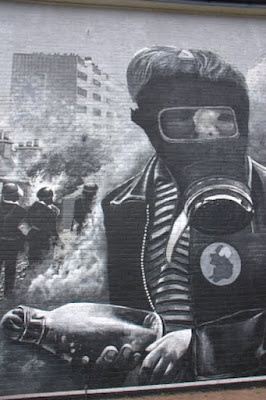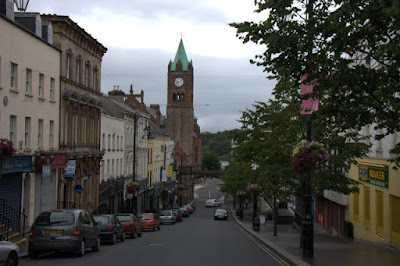Did she say what we thought she said?
The big news in Derry was that it had been named the UK City of Culture for 2013 shortly before we arrived. I wish I could paint a picture of Derry as the tourist brochures do: modern and cutting edge and the only city in Europe to be encircled by fully intact historic city walls. No mention of any problems.
But one can’t deny that Derry is still a conflicted city. Residents cannot even agree on its name. Derry should have been part of Ireland when the British took over Northern Ireland, but due to its economic success, the British reached around the river border to include it in Northern Ireland. The result is that some people call it Derry, its Irish name; others call it Londonderry, its British name. (Derry is its official name, but even on maps, you will see it both ways).
When we arrived in Derry, road blockages forced us to take a detour to the B&B at which we planned to stay. As we tried to navigate around, we passed a police vehicle with grates and armored sides that looked more like a military vehicle than anything else. Did you see that? They’re hard core here, I remarked to Sean.
After checking in at the B&B, we walked to the center city to get something to eat. It was eerily quiet on our walk there. We didn’t pass many people, and when we arrived in the center, everything looked deserted. When the hosts at our B&B gave us recommendations for dinner at the B&B, they mentioned a pedestrian-only street. We pictured something quaint, but what we saw was a street partitioned from the streets with traffic with barricades. Wow, is this town dead, one of us said. Maybe because it is Sunday?, the other suggested.
We found the recommended restaurant and had a nice dinner. We took a taxi back to the B&B, and asked the taxi driver if things were always this quiet. He mumbled something about things being busier on the weekends. When we got back to the B&B, we were talking to our host about the problems we were having connecting to the internet. Oh, she said, we’ve been having trouble with the internet all day since the bomb this morning. She kept talking, but I didn’t hear what else she said after that. It was hard to tell with her accent and all, but I was pretty sure she said bomb. I looked at Sean. From the expression on his face, I was pretty sure he was pretty sure she said bomb too. Did you say… I trailed off. Bomb? Sean finished for me. Oh. Her face fell. You didn’t hear? No, we said in unison. Oh, she said, in an offhand fashion, just some small minded individuals being stupid. No one was hurt.
She continued talking about the problems with the internet. I wanted to know more about this bomb. I wasn’t sure whether she was trying to play off the bomb as no big deal because she didn’t want to scare away potential business or because something like this was a common occurrence. Sean and I pressed her for more information, and found out that a splinter group of the IRA had hijacked a taxi driver around 3 a.m. that morning, held him at gunpoint while he drove to the police station and planted the bomb at the police station. Luckily, no one was hurt. According to our host, this sort of thing hadn’t happened in a while, but every once in a while “small-minded” people who do not have the support of the community liked to stir up trouble. She said this type of activity used to be supported by some people, but these days everyone wants to move past it.
This whole bomb thing explained a lot: why the road was barricaded off (it was the road where the police station was located), why downtown was dead and barricaded.
The next day, we visited the Bogside, a predominantly Irish/Catholic/Republican neighborhood. (Republicans believe that the Republic and Northern Ireland should be united as one whole, and believe they have been discriminated against and oppressed by English rule). The Bogside is a neighborhood with a past; it was the scene of much violence. It is where Bloody Sunday occurred in 1972; 14 people were killed when British soldiers opened fire on an otherwise peaceful protest about civil rights and discrimination against Catholics.
The reason we visited the Bogside, as many tourists to Derry do, was to see the political murals. All of the murals are large, imposing, dominant; some are menacing, some are peaceful and in remembrance. They are painted right on the side of buildings containing housing. As an outsider, it is hard to understand how people can move on with their lives when they have to walk by the murals every day, right in their neighborhoods. For them, do they blend in just as much as lawn decorations? Or are they a constant reminder about what happened? Yet you can’t just paint over them, and erase the past.

I found it sad that years after the ceasefire, there were bombs being set off, even if it was by a small minority without community support.
That there were police, with military-like vehicles, and machine guns, standing right next to the mural in remembrance of those who died on Bloody Sunday.
That the planting of a bomb is not necessarily an isolated incident. That we as tourists can’t focus on the Derry presented in the brochures. That people are still resorting to past methods instead of focusing on the future.
Note: Unlike Australia, the United States State Department has not declared a formal travel warning about travelling to Northern Ireland, but does urge travelers to use caution. While occasionally incidents like the bomb that was planted the morning we arrived do crop up from time to time, overall it is fine to travel to Derry. You may want to check the latest travel warnings before you go.










Oh my, maybe you should be heading home now? 🙁 You never told me a word about Derry! I’m glad you’re two countries past there by now. Ironically I was just showing my friends the murals of Pittsburgh being painted on our brick buildings ~ but they depict good history and are nowhere near as disturbing as those in Derry. How sad that they have to focus on the negative ~ of course, they should remember their loved ones lost but the last mural with the butterfly is a much gentler way to do that.
Not all of the murals focus on negative things. I took pictures of all of them, with the descriptions, and you can see that some of them focus on peace. The murals tell the story of what happened, and unfortunately, negative things happened. Here is a link to the website from the artists who painted the murals, which explain a little more about them: http://www.bogsideartists.com/
Glad you’re safe. The murals are really interesting.